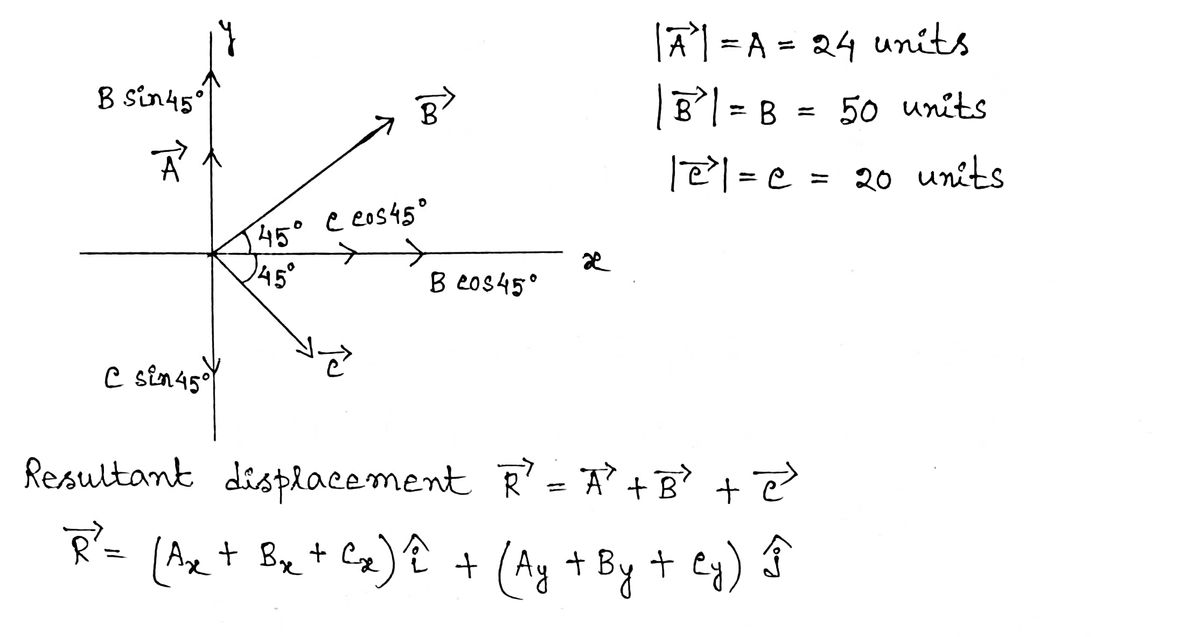Three displacement vectors are plotted on an x y plane. Vector A, the shortest of the three, starts at the origin and extends up along the positive y axis. Vector B, the longest of the three, starts at the origin and extends into the first quadrant at an angle of 45.0° from the positive xaxis. Vector C, whose magnitude is between that of vectors A and B, starts at the origin and extends into the fourth quadrant at an angle of 45.0° from the positive xaxis. (a) Find the resultant in unit-vector notation. R = units (b) Find the magnitude and direction of the resultant displacement. magnitude unit(s)
Three displacement vectors are plotted on an x y plane. Vector A, the shortest of the three, starts at the origin and extends up along the positive y axis. Vector B, the longest of the three, starts at the origin and extends into the first quadrant at an angle of 45.0° from the positive xaxis. Vector C, whose magnitude is between that of vectors A and B, starts at the origin and extends into the fourth quadrant at an angle of 45.0° from the positive xaxis. (a) Find the resultant in unit-vector notation. R = units (b) Find the magnitude and direction of the resultant displacement. magnitude unit(s)
College Physics
11th Edition
ISBN:9781305952300
Author:Raymond A. Serway, Chris Vuille
Publisher:Raymond A. Serway, Chris Vuille
Chapter1: Units, Trigonometry. And Vectors
Section: Chapter Questions
Problem 1CQ: Estimate the order of magnitude of the length, in meters, of each of the following; (a) a mouse, (b)...
Related questions
Question
Three displacement vectors of a croquet ball are shown in the figure, where
|A| = 24.0 units,
|B| = 50.0 units,
and
|C| = 20.0 units.
Three displacement vectors are plotted on an x y plane. Vector A, the shortest of the three, starts at the origin and extends up along the positive y axis. Vector B, the longest of the three, starts at the origin and extends into the first quadrant at an angle of 45.0° from the positive xaxis. Vector C, whose magnitude is between that of vectors A and B, starts at the origin and extends into the fourth quadrant at an angle of 45.0° from the positive xaxis.
(a) Find the resultant in unit-vector notation.
(b) Find the magnitude and direction of the resultant displacement.
R =
units
(b) Find the magnitude and direction of the resultant displacement.
| magnitude | unit(s) |
| direction | ° counterclockwise from the +x axis |

Transcribed Image Text:B
45.0⁰
/45.0°
-x
Expert Solution
Step 1

Step by step
Solved in 3 steps with 3 images

Knowledge Booster
Learn more about
Need a deep-dive on the concept behind this application? Look no further. Learn more about this topic, physics and related others by exploring similar questions and additional content below.Recommended textbooks for you

College Physics
Physics
ISBN:
9781305952300
Author:
Raymond A. Serway, Chris Vuille
Publisher:
Cengage Learning

University Physics (14th Edition)
Physics
ISBN:
9780133969290
Author:
Hugh D. Young, Roger A. Freedman
Publisher:
PEARSON

Introduction To Quantum Mechanics
Physics
ISBN:
9781107189638
Author:
Griffiths, David J., Schroeter, Darrell F.
Publisher:
Cambridge University Press

College Physics
Physics
ISBN:
9781305952300
Author:
Raymond A. Serway, Chris Vuille
Publisher:
Cengage Learning

University Physics (14th Edition)
Physics
ISBN:
9780133969290
Author:
Hugh D. Young, Roger A. Freedman
Publisher:
PEARSON

Introduction To Quantum Mechanics
Physics
ISBN:
9781107189638
Author:
Griffiths, David J., Schroeter, Darrell F.
Publisher:
Cambridge University Press

Physics for Scientists and Engineers
Physics
ISBN:
9781337553278
Author:
Raymond A. Serway, John W. Jewett
Publisher:
Cengage Learning

Lecture- Tutorials for Introductory Astronomy
Physics
ISBN:
9780321820464
Author:
Edward E. Prather, Tim P. Slater, Jeff P. Adams, Gina Brissenden
Publisher:
Addison-Wesley

College Physics: A Strategic Approach (4th Editio…
Physics
ISBN:
9780134609034
Author:
Randall D. Knight (Professor Emeritus), Brian Jones, Stuart Field
Publisher:
PEARSON